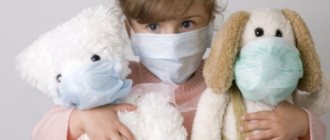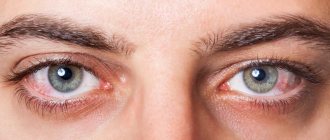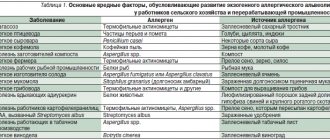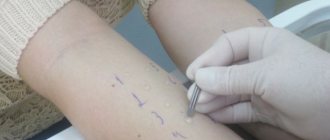General information
Coughing is a reflex reaction of the body, which is aimed at removing from the respiratory tract not only sputum, foreign bodies, but also various irritants (dust, smoke, aerosols of chemicals).
Allergies are the most common cause of cough. Various manifestations of allergies are observed in 40% of people, which is associated with poor ecology, unhealthy diet (preservatives, dyes) and the widespread use of household chemicals. Manifestations of allergies can be from the nose, pharynx, lower respiratory tract, skin or gastrointestinal tract. A cough reaction can be the main symptom of an allergy. In this case, it is not necessary that the bronchial mucosa is affected - it could be allergic pharyngitis or laryngitis , which also cause coughing. Almost all patients with chronic cough show signs of allergies and respond to treatment with glucocorticosteroids and antihistamines, but there are no signs of bronchial asthma or allergic rhinitis . This type of cough is called allergic.
Allergic cough in adults appears in the spring during the flowering of poplars and can last all summer until the ragweed blooms. In adults, this problem may be associated with harmful production conditions (gas contamination, inhalation of welding aerosols or paints). This problem does not bypass children either. In addition, they are more likely to experience bronchial obstruction (attacks of difficulty breathing). If symptoms appear, you should consult a doctor, since this pathology cannot “go away on its own”, and over time only becomes more severe with complications. Many authors consider allergic cough as one of the variants of bronchial asthma .
Pathogenesis
An allergic cough develops when an allergen enters the respiratory tract, and in response to this, class E immunoglobulins are produced. Basophils, eosinophils and mast cells are of great importance in the development of respiratory allergosis. They are the components of the inflammatory reaction in the bronchi. During allergic reactions, histamine is produced in high concentrations. This powerful mediator causes a wide range of effects: increased vascular permeability, contraction of smooth muscles, itching. The biochemical interaction of histamine with immunoglobulin E proceeds as an avalanche-like chain reaction, so an allergic reaction quickly appears and develops with great speed.
The mucous membrane of the bronchial tree is characterized by pronounced edema, while mucus secretion is disrupted and sputum transport worsens.
There are three phases in the pathogenesis of immune inflammation.
- Immunological . It is associated with the interaction of the allergen with macrophages - this produces specific antibodies. B lymphocytes synthesize IgE, which circulates in the blood and is deposited on mast cells and smooth muscles.
- Pathochemical reaction . At this stage, the leading role is given to mast cells (basophils). histamine and tryptase are released 20 minutes after interaction with the allergen during degranulation . After 2-5 hours, second-order mediators ( thromboxanes , leukotrienes , prostaglandins ) are released.
- Pathophysiological phase . During this phase, under the influence of inflammatory mediators, the bronchi are damaged - capillary permeability increases, cellular infiltrates are formed and edema develops. At this stage there are already clinical manifestations, which is associated with increased bronchial reactivity and narrowness of the airways (the obstructive component increases).
Classification
If we consider cough as a reaction of the body, then there are the following classifications of it.
The nature:
- Unproductive (no phlegm, dry).
- Productive (with sputum).
By expression:
- Coughing.
- Easy.
- Strong.
By duration:
- Paroxysmal.
- Episodic.
- Constant.
With the flow:
- Acute (lasts up to three weeks).
- Protracted (from three weeks to three months).
- Chronic (more than three months).
According to the American guidelines for the diagnosis of cough, it is considered chronic if it is present daily and lasts more than 4 weeks in children and more than 8 weeks in adults.
By etiology:
- Infectious.
- Non-infectious.
- Allergic.
When considering allergic bronchitis, you need to indicate its forms:
- allergic tracheobronchitis - the bronchi and trachea are affected by the allergic and inflammatory process;
- atopic - characterized by an increased IgE-mediated response, the disease occurs with pronounced symptoms and rapidly progresses;
- obstructive - inflammation covers the larynx, which makes breathing difficult;
- infectious-allergic - has a sluggish course, clinical manifestations are not very pronounced.
An allergic cough is dry and irritating, does not change during the day, but gets worse at night. It occurs not only when exposed to irritants, but also to cold air and when talking, and can begin with a sore throat.
Do not forget that there is cough asthma, in which the only symptom is a cough. The cough variant of asthma is the most common cause of chronic cough. With this form there is no wheezing or shortness of breath, but there is hyperreactivity of the respiratory tract. Cough-induced asthma is expressed by severe attacks of coughing, which most often begin at night, and is aggravated by viral infections of the respiratory tract, when inhaling dust, vapors, or cold air. Diagnostic criteria for cough asthma are:
- chronic irritating cough at night;
- positive bronchoprovocation test ;
- positive bronchodilator response ;
- anti-asthmatic therapy is effective , the basis of which is inhaled glucocorticosteroids and long-acting beta-2 agonists.
Cost of treatment for allergic bronchitis
The cost of treatment for allergic bronchitis for each patient is calculated individually, taking into account factors such as:
- degree of neglect of the pathology;
- presence of associated complications
- duration of therapy, etc.
It's cheaper with us
- Beneficial programs for annual placement, pregnancy management, medical examination and “check-up” with discounts from the price list to 25%
- Discounts for disabled people, veterans, pensioners 10%
- Discount on deposit program up to 25%
- Discounts on promotions and seasonal offers up to 50%
Causes
The cause is various allergens:
- Household dust. It contains microscopic mites and their metabolic products, particles of the chitinous shell, which have a pronounced allergenic effect.
- Pollen. In adults, plant pollen is the leading allergen.
- Epidermis and animal fur.
- Cigarette smoke.
- Animal poison.
- Food. Food allergies in childhood increase the risk of allergic cough.
- Perfumes and cosmetics.
- Household chemicals.
- Smoke.
- Latex.
- Inhalation medications.
Provoking factors may be:
- Smoking.
- Stress.
- Unfavorable production conditions.
- Unfavorable environment.
- Hormonal changes.
- Poor nutrition.
- Genetic predisposition.
Symptoms of an allergic cough
First of all, how can you determine if your or your child’s cough is due to an allergy? Often, attacks of allergic cough are associated with a “cold” or ARVI, due to the fact that in some cases it can be accompanied by a sore throat, runny nose and sneezing. How to distinguish an allergic cough from a cold? Cough associated with allergies has characteristic features:
- Sudden prolonged attacks. The cough begins suddenly against the background of good health.
- No elevated temperature.
- Dry (no sputum) and irritating cough.
- Disturbs the patient at night.
- Difficulty breathing (feeling of suffocation).
Other symptoms that may also be present include a runny nose, nasal congestion, itchy eyes, and watery eyes. Seasonal allergies begin with these symptoms, and then a cough joins. Inflammation of the upper respiratory tract of an allergic nature ( allergic rhinitis , pharyngitis and laryngitis ) can provoke the development of cough. When considering allergic rhinitis , symptoms in adults include:
- itching in the nose;
- sneezing;
- nasal discharge;
- itchy eyes.
Allergic pharyngitis is manifested by a sore throat and cough that occurs in paroxysms. With allergic rhinitis, the mucous membrane is pale and swollen. There is serous discharge inside the nasal cavity. However, you need to know that an allergic cough may be the only symptom.
How to find out what caused the cough?
There are several signs to suspect an allergic cough:
- Duration. With a cold, the cough usually lasts several days, a maximum of two weeks, and with allergies, until contact with the allergen stops, it will not disappear. Therefore, if the cough does not go away within two weeks, this is a reason to contact an allergist.
- Season. Cold coughs typically appear in winter, while allergies tend to occur at any time of the year.
- Intensity. An allergic cough immediately manifests itself, while with a cold the intensity of the cough increases gradually.
- Typical allergic symptoms: itching, nasal congestion, pain in the eyes and lacrimation.
- Absence of high fever typical of colds and viral infections.
Tests and diagnostics
- If an allergic origin of a cough is suspected, each patient is carefully asked about the presence of various manifestations of allergies and the situations that provoke the attack, the time of its onset and specific complaints.
- Clinical blood test. An increase in the level of neutrophils, eosinophils and ESR is determined. The level of eosinophils increases in allergic and parasitic diseases.
- Sputum analysis (eosinophils are detected).
- Determination of specific IgE antibodies.
- Injection skin tests (performed from two years of age).
- Chest X-ray. It is performed in patients with chronic cough. If pathological changes are detected, spirometry and bronchography are further performed.
- CT scan of the chest. It is necessary to identify lesions in the lungs, lesions of the interstitium of the lungs and enlarged mediastinal lymph nodes, which may be the cause of chronic cough.
- Testing the sensitivity of cough receptors. They do a provocative test (the patient inhales aerosol particles of capsaicin, which stimulate the receptors), which causes a cough. The cough threshold is determined by the concentration of inhaled particles. With an allergic cough, increased sensitivity is observed.
Allergic cough, unlike bronchial asthma, is characterized by:
- Normal pulmonary function tests.
- No airway hyperresponsiveness.
Allergic cough in a child
An allergic cough in a child is a manifestation of an allergy. It appears in response to the penetration of an allergen into the respiratory tract. The reasons that cause this pathology in a child are:
- Inhalation of dust, plant pollen, animal epidermis, aerosol substances, tobacco smoke (passive smoking).
- Ingestion of mold spores into the respiratory tract, which causes infectious and allergic inflammation.
- Helminthiases and protozoal infections.
- Chronic bacterial infection
- Food.
In a young child, the trigger for an allergic cough in most cases is hypersensitivity to food products (food allergy). Food allergens in childhood include cow's milk, wheat, eggs, fish, chocolate, nuts, strawberries, and citrus fruits.
What is a cough due to allergies in children? Its distinctive features:
- paroxysmal form;
- rough, dry cough (without sputum production or with scant production);
- occurs at any time, but worsens at night;
- duration - weeks and even months;
- no signs of infection (fever, chills).
In this case, the child may have sneezing, watery eyes, redness and itching of the eyes. A prolonged cough is accompanied by chest pain due to muscle strain. If there are symptoms of an allergic cough in a child, it is important not to miss bronchial asthma .
How does the disease manifest itself?
Allergic bronchitis causes acute symptoms in adults, so it is better not to self-medicate and visit a doctor as soon as possible. After contact with an allergenic irritant, the following clinical picture develops:
- Dry, unproductive cough. As a result of irritation and swelling of the mucous membrane, a person suffers from a barking, scratchy, unproductive cough. Sputum does not come out well, sometimes there is none at all. The patient cannot cough well and feels discomfort in the chest. A dry cough can get worse at night, preventing a person from getting a good night's sleep and rest.
- Expiratory dyspnea. In the initial stages of development of bronchitis of an allergic nature, shortness of breath does not bother you. However, as mucus accumulates in the bronchi, breathing problems appear. The patient cannot take a full breath and complains of pain in the chest.
- Swelling of the mucous membrane. An allergen, having entered the body through the respiratory system, first of all causes irritation of the mucous membrane. Therefore, in addition to a dry cough, a person may be bothered by excessive lacrimation, runny nose, swelling of the nasopharynx, and allergic conjunctivitis.
Prolonged coughing attacks and breathing problems cause the development of non-specific symptoms:
- weakness, lethargy;
- headaches, dizziness;
- sore throat, hoarse voice.
On average, the exacerbation period lasts 3–4 days. After this, acute symptoms gradually disappear, and the disease goes into remission. Allergic bronchitis, which is not treated or treated incorrectly, can lead to the development of severe complications, such as:
- pneumonia;
- bronchial asthma;
- damage to the walls of the bronchi;
- pulmonary emphysema;
- respiratory, heart failure;
- embolism;
- pneumosclerosis.
Treatment of allergic cough in a child
- First of all, it is necessary to identify and eliminate the allergen .
- When an allergen is identified, perform allergen-specific immunotherapy (subcutaneous or sublingual). In children, this treatment method is effective. Conducted from the age of 5 years.
- Taking antihistamines to eliminate inflammation. It is rational to use second and third generation drugs approved by age. For example, Allerzin can be used from 6 months. First generation antihistamines have a “drying” effect on the mucous membrane and thicken the mucus even more.
- Combating bronchospasm. Broncho-obstructive syndrome in children under 4 years of age is infectious-allergic in nature and the likelihood of obstruction of allergic origin increases with the age of the child. In children with an allergic history, bronchospasm develops in 40% of cases. Also, bronchial obstruction is more often observed in those who frequently suffer from respiratory infections. With viral inflammation, swelling of the bronchial wall, hypersecretion of mucus, desquamation of the ciliated epithelium and bronchospasm develop under the influence of active substances that are released during the inflammatory reaction. Children from 3 years of age can be prescribed
- Bronholitin. Ephedrine reduces swelling and eliminates bronchospasm, facilitates sputum separation. The effect of ephedrine appears after 30 minutes and lasts up to two days. Glaucine suppresses cough without depressing the respiratory center.
- Another effective and safe drug that can be used in a child from 2 years of age is Ascoril (contains guaifenesin + bromhexine + salbutamol ). In young children, nonproductive cough is associated with increased secretion viscosity, and bromhexine and guaifenesin reduce its viscosity.
- Salbutamol, in addition to its anti-inflammatory effect, facilitates the removal of sputum and reduces increased bronchial tone.
- What are the principles of treating bronchial obstruction in children? Inhalation delivery of drugs—nebulizer therapy—is convenient for them. Nebulizers do not require the participation of a small patient and generate a moist aerosol. A bronchodilator drug for emergency use at home is Berodual . The dose required by age is diluted with saline and inhaled through a nebulizer. Children under 6 years old take 2 drops per kg of weight for 1 inhalation. The interval between inhalations is 4–6 hours (repeat inhalations 4 times a day).
- Glucocorticosteroid therapy. Prescribed for severe condition of the child. Today, effective and safe inhalation therapy is used. Budesonide suspension ( Pulmicort ) via nebulizer is allowed from 6 months. You can combine Pulmicort with Berodual in one inhalation.
- Expectorants. For bronchial obstruction, mucolytic therapy in young children is necessary because they have narrow airways. The presence of obstruction impairs the removal of sputum. Therefore, in parallel with bronchodilators, moisturizers and expectorants are prescribed. The most effective in children are mucolytics based on ambroxol ( Lazolvan ), which can be used through a nebulizer even in newborns. The drug acts quickly and is active for 6-10 hours.
- By liquefying, sputum does not increase in volume, which is important for small children who cannot cough it up. It is also important that there are different dosage forms of Lazolvan: solution for inhalation, syrup, lozenges and tablets.
Treatment of allergic bronchitis
Allergic bronchitis symptoms and treatment in adults is carried out after a comprehensive diagnostic examination. The diagnosis is made on the basis of an initial examination of the patient, a detailed study of the medical history, and laboratory and instrumental diagnostic examinations.
To identify the inflammatory process in the bronchi, the doctor gives directions for the following procedures:
- general blood analysis;
- bacteriological culture of sputum;
- chest x-ray;
- spirometry.
It is also important to identify the allergen, because without eliminating it, drug treatment will not bring the desired results and upon subsequent contact with the irritant, the disease will recur.
To identify the pathogen, the following procedures are prescribed:
- allergy tests;
- blood test for immunoglobulins;
- immunoblotting.
A person prone to allergic reactions must exclude from life all factors that provoke an acute immune response:
- dust;
- animals;
- clothes made from natural wool;
- bedding with fillings such as down and feathers;
- some products, for example, honey, citrus fruits, chocolate, etc.;
- aggressive hygiene and washing products;
- some medicines.
If the allergen is no longer present in a person's life, the risk of recurrence of allergic bronchitis will be minimized. To prevent exacerbations, it is important to follow the rules of a healthy lifestyle:
- give up bad habits such as alcohol, cigarettes;
- improve nutrition;
- give preference to active pastime to a sedentary lifestyle;
- undergo sanatorium-resort treatment once a year;
- eliminate the stress factor.
To relieve the pathological symptoms of bronchitis of an allergic nature, certain groups of medications are prescribed:
- Antihistamines. They block the histamine receptor, stopping the acute immune response to a foreign protein.
- Expectorants, mucolytics. The drugs dilute the secretion and accelerate its removal from the bronchi. Mucoltics are used to thin the cough, and after the cough becomes productive, the doctor prescribes expectorants. There are new generation medications that combine the effects of mucolytics and expectorants.
- Glucocorticoids. They are prescribed only in exceptional situations when attacks of allergic bronchitis cannot be controlled with the above medications. Drugs in this group have anti-inflammatory and antiallergic effects, help relieve swelling, and reduce vascular permeability. The course of therapy and dose are determined by the doctor individually. Including glucocorticosteroids into your treatment regimen on your own is fraught with negative consequences and complications.
- Sedatives. Some patients who have experienced attacks of allergic bronchitis are terrified of their recurrence. They are worried about the fear of death from suffocation, panic attacks at the slightest breathing problems. To make you feel better and reduce psycho-emotional stress, the doctor will prescribe sedatives.
In order for drug therapy to give the most positive effect, it is recommended to additionally follow simple measures to prevent the disease:
- change bed linen daily and do wet cleaning of the room;
- try to completely eliminate contact with allergens, including aggressive hygiene products, powders, and detergents;
- ventilate the room several times a day;
- remove objects that collect dust from the room: carpets, upholstered furniture and toys, books, curtains;
- try not to contact pets.
A healthy lifestyle, proper nutrition, giving up bad habits and eliminating irritating factors will help avoid exacerbation of allergies, the development of allergic bronchitis and its complications.
Make an appointment with a doctor
Diet
Hypoallergenic diet
- Efficacy: therapeutic effect after 21-40 days
- Timing: constantly
- Cost of products: 1300-1400 rubles. in Week
With food allergies, patients must strictly adhere to a hypoallergenic diet . However, for other allergic diseases, highly allergenic foods must be excluded from the diet. The diet should be complete in terms of protein (110-120 g), fat (120 g) and carbohydrates (200 g). The diet should be rich in vitamins, so it is important to diversify the diet with permitted fruits, berries, vegetables and their juices. You should limit salt, salty foods (marinades, pickles, sausage, dried fish, cheese) and smoked foods, which increase allergic manifestations.
Products that often cause allergies are excluded:
- citrus;
- nuts;
- Fish and seafood;
- eggs;
- smoked meats;
- mayonnaise, ketchup, mustard;
- tomatoes;
- mushrooms;
- eggplant;
- Strawberry wild-strawberry;
- pineapple, melon;
- chocolate;
- coffee;
- honey.
Limit the consumption of confectionery and sugar.
Patients' diets may include:
- rabbit, veal, beef;
- cereal and vegetable soups, cabbage soup, beetroot soup;
- vegetable oil and butter;
- plums, prunes, cherries, pears, watermelon, gooseberries, cranberries, blueberries, green apples;
- potatoes, all types of cabbage, zucchini, beets, dill, parsley, onions, pumpkin, seasonal cucumbers;
- dairy products;
- buckwheat, rice and oatmeal porridge;
- black and white bread, lean dry bread, homemade pies without eggs.
Prevention
Prevention of this disease in children and adults includes:
- Elimination of dust sources (books, carpets, feather pillows, plush toys).
- Regular wet cleaning using safe household chemicals.
- Intensive ventilation of the room.
- Air humidification and ionization.
- Do not use air fresheners or aerosol perfumes.
- The use of hypoallergenic cosmetics.
- Minimize contact with animals.
- During the flowering of herbs, reduce the time spent in the air, do not open windows in the apartment during this period, use nasal filters or medical masks.
- Change a profession associated with occupational hazards.
- During pregnancy and breastfeeding, exclude highly allergenic foods from the diet.
- If you have a food allergy, stick to your diet.
Predisposing factors
Allergic bronchitis, the symptoms of which in adults and children are almost identical, usually proceeds according to a certain pattern. Penetration of a foreign allergen protein into the body provokes an inadequate immune response, which is manifested by profuse lacrimation, sneezing, and coughing. If the irritant is not promptly eliminated and the symptoms progress, reserve protection is activated, accompanied by hyperspasm of the bronchial tree and swelling of the ciliated mucosa that lines the internal respiratory organs.
As a result of constant irritation, the lung tissue begins to produce thick mucus, which gradually accumulates in the alveoli and becomes a source of bacterial infection. Stagnation and infection of mucus in the bronchi is the main cause of allergic bronchitis.
If a person has a strong immune system and good health, infection of bronchial tissues rarely occurs. The defense system quickly destroys the infection, preventing it from actively multiplying and spreading to healthy structures. But if the immune system is weakened and a person is prone to allergies, then under the influence of predisposing factors the risk of developing allergic bronchitis increases significantly.
Reasons that provoke the development of bronchitis of an allergic nature:
- abuse of bad habits;
- congenital or acquired immunodeficiency;
- unbalanced diet;
- passive smoking;
- living in an unfavorable environmental environment;
- uncontrolled use of drugs;
- lack of competent treatment for allergic diseases;
- inactive lifestyle;
- use of bedding with natural fillings: down, feathers;
- work with industrial hazards, involving constant contact with chemical or organic substances.
For a long time, the immune system can suppress a foreign irritant that regularly penetrates the body, so a person will not suspect a tendency to allergies. But at a certain point, all the predisposing factors converge at one point, as a result of which a serious disease begins to progress sharply, the consequences of which sometimes have to be fought throughout life.
List of sources
- Bunyatyan N.D., Uteshev D.B., Sviridenko A.V. Diagnosis and treatment of cough in the practice of a general practitioner. /Russian Medical Journal (RMJ), 2010. - 18(18). — P. 1145-1149.
- Kuzmenko L.G. Dry nonproductive cough in children. /Attending physician, 2005 - No. 8. - P. 8–18.
- Radtsig E.Yu. Cough is a defense mechanism and symptom of respiratory tract infections. / Pediatrics, 2009, 88(5), pp. 12–117.
- Zaitseva S.V., Murtazaeva O.A. Bronchial obstruction syndrome in children // Difficult patient. 2012. No. 2–3. pp. 34–39.
- Soroka Yu. A. Broncho-obstructive syndrome in pediatric practice // Child’s Health. 2006. No. 2. pp. 77–81.
At President-Med clinics you can
- undergo examination and treatment in more than 30 medical specialties, rehabilitation after strokes, surgeries, injuries,
- pass various types of tests (more than 5,000 types of tests and laboratory tests),
- undergo functional diagnostics (ultrasound, endoscopy: gastroscopy), ECG, installation and interpretation of ABPM and Holter ECG and others,
- pass a medical examination in one day, undergo a medical examination (for both organizations and individuals), undergo a medical examination (for both organizations and individuals),
- obtain all kinds of certificates - certificates from the traffic police and for admission to sports, to purchase weapons, to a sanatorium,
- if there is evidence, issue a certificate of temporary incapacity for work,
- draw up and receive other types of medical documentation,
- make any injections,
- use the services of one-day surgery or day hospital.









